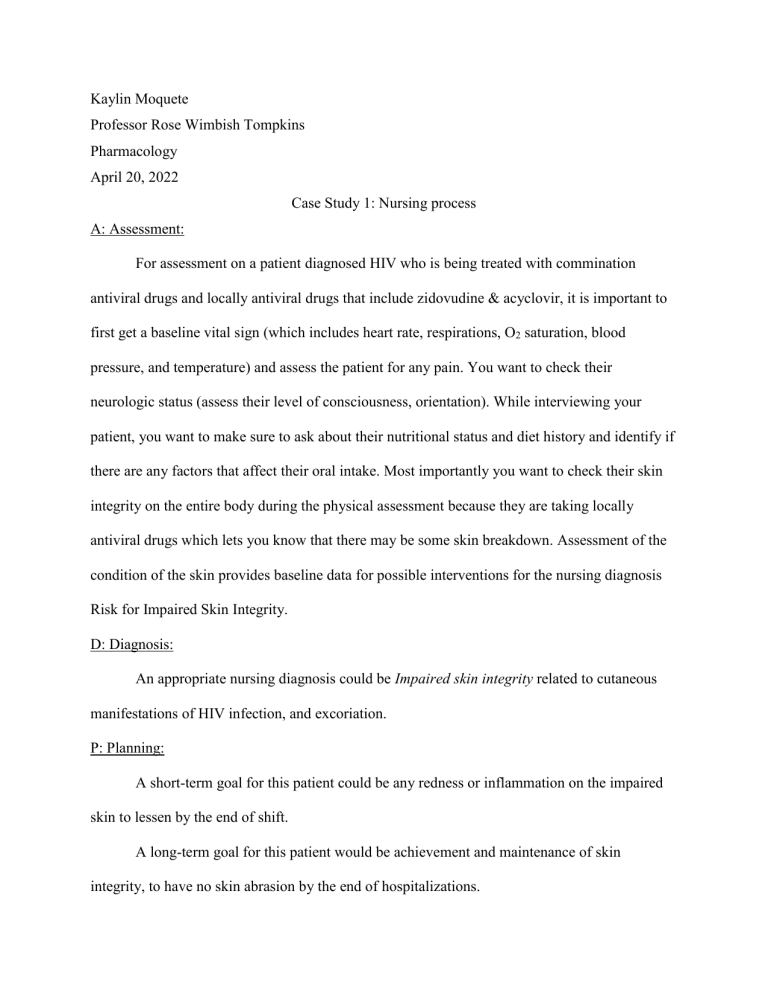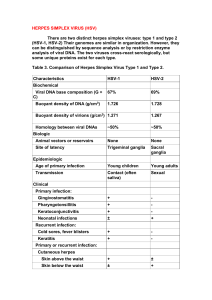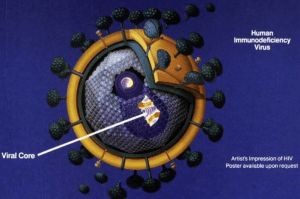
Kaylin Moquete Professor Rose Wimbish Tompkins Pharmacology April 20, 2022 Case Study 1: Nursing process A: Assessment: For assessment on a patient diagnosed HIV who is being treated with commination antiviral drugs and locally antiviral drugs that include zidovudine & acyclovir, it is important to first get a baseline vital sign (which includes heart rate, respirations, O2 saturation, blood pressure, and temperature) and assess the patient for any pain. You want to check their neurologic status (assess their level of consciousness, orientation). While interviewing your patient, you want to make sure to ask about their nutritional status and diet history and identify if there are any factors that affect their oral intake. Most importantly you want to check their skin integrity on the entire body during the physical assessment because they are taking locally antiviral drugs which lets you know that there may be some skin breakdown. Assessment of the condition of the skin provides baseline data for possible interventions for the nursing diagnosis Risk for Impaired Skin Integrity. D: Diagnosis: An appropriate nursing diagnosis could be Impaired skin integrity related to cutaneous manifestations of HIV infection, and excoriation. P: Planning: A short-term goal for this patient could be any redness or inflammation on the impaired skin to lessen by the end of shift. A long-term goal for this patient would be achievement and maintenance of skin integrity, to have no skin abrasion by the end of hospitalizations. I: Implementation: An important nursing intervention for this patient is to promote skin integrity. The nurse should encourage the patient to avoid scratching; to use nonabrasive, nondrying soaps and apply nonperfused moisturizers; to perform regular oral care; and to clean the perianal area after each bowel movement with nonabrasive soap and water. It is also important to administer the medication as ordered to control any skin breakouts from the infection caused by HIV. Before administering the medications, the nurse would educate the patient on the meds that they are receiving and make sure they are aware and okay with it. The medications to be given are Zidovudine and acyclovir. Zidovudine (brand name Retrovir) is an antiretroviral drug or nucleoside reverse transcriptase inhibitor and is indicated for HIV infection (with other antiretrovirals). Unlabeled Use: Chemoprophylaxis after occupational exposure to HIV. Its mechanism of action works as follows: Following intracellular conversion to its active form inhibits viral RNA synthesis by inhibiting the enzyme DNA polymerase and prevents viral replications. Zidovudine’s therapeutic Effect is virustatic action against selected retroviruses. Slowed progression and decreased sequelae of HIV infection. Decreased viral load and improved CD4 cell counts. Most common side effects are headache, weakness, anxiety, confusion, abdominal pain, diarrhea, nausea, anemia, and granulocytopenia. Some possible critical or life threating side effects are seizures, hepatomegaly (with steatosis), pancreatitis, lactic acidosis. The safe dosage for Zidovudine is PO (adults) 100mg q 4 hr. while awake or 200mg 3 times daily or 300 mg twice daily (depending on commination and clinical situation). IV (Adults and Children >12 yr.): 1 mg/kg infused over 1 hr. q 4 hr. Change to oral therapy as soon as possible. Lactation (breast feeding) and hypersensitivity are contraindicated for this drug. Zidovudine is combined with acyclovir. Acyclovir is classified as an antiviral and in indicated for treatment of herpes zoster (shingles), treatment/suppression of genital herpes, reduction of transmission of genital herpes treatment of chickenpox, and treatment of herpes labialis (cold sores). Its mechanism of action is rapidly converted to acyclovir. Acyclovir interferes with viral DNA synthesis and the therapeutic effect is inhibited viral replication, decreased viral shedding, reduced time to healing of lesions and reduced transmission of genital herpes. It is contraindicated in hypersensitivity to valacyclovir or acyclovir. Some common sides are headache, and nausea. Most life threating side effects are renal failure, crystalluria, thrombotic thrombocytopenic purpura/hemolytic uremic syndrome (very high doses in immunosuppressed patients). The safe dose for acyclovir suppression of recurrence in HIV-infected patients is 500mg q 12 hr. and for reduction of transmission is 500mg once daily for source partner. E: Evaluation: During the end of shift the nurse would check to see if his/her goal was met. For example, the nurse documented that by the end of the shift the skin lesions appeared to be less red and on a pain scale of 1-10 the patient verbalized that the pain level went from a level 6 to a level 3 or 4. In this example we can say that the short-term goal was met. The following nurse’s responsibility would then be to continue to achieve or maintain skin integrity so that the patient can be discharged. Works Cited Vallaerand, A.H. & Sanoski. Davis Drug Guide for Nurses 17th edition. 2019. Wolter kluwer health. "Handbook of Nursing Diagnosis 14th edition." Carpenito, Lynda Juall. Appendix A. Philadelphia: Blackwell Publishing Limited, a company of John Wiley & Sons, Inc., 2013. 350-361.


